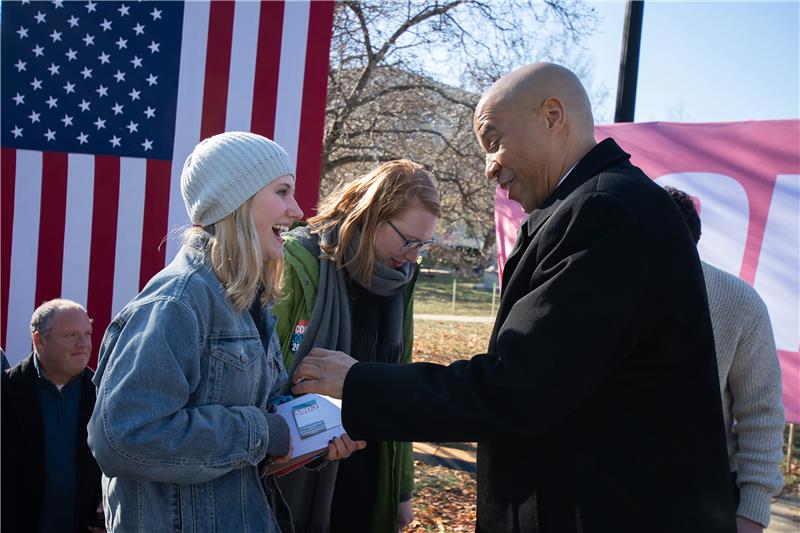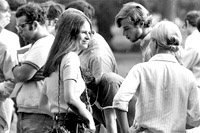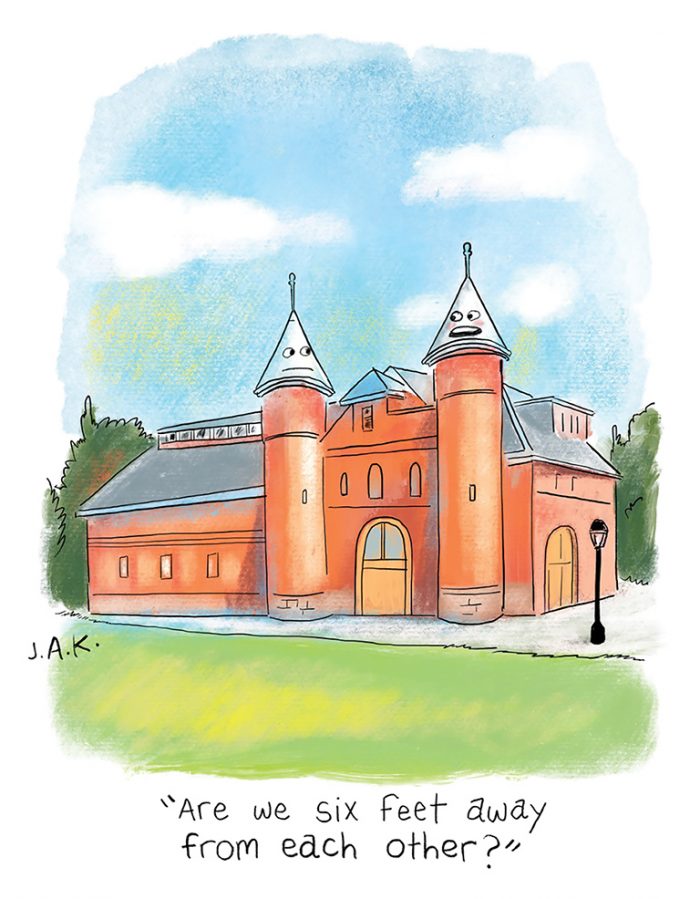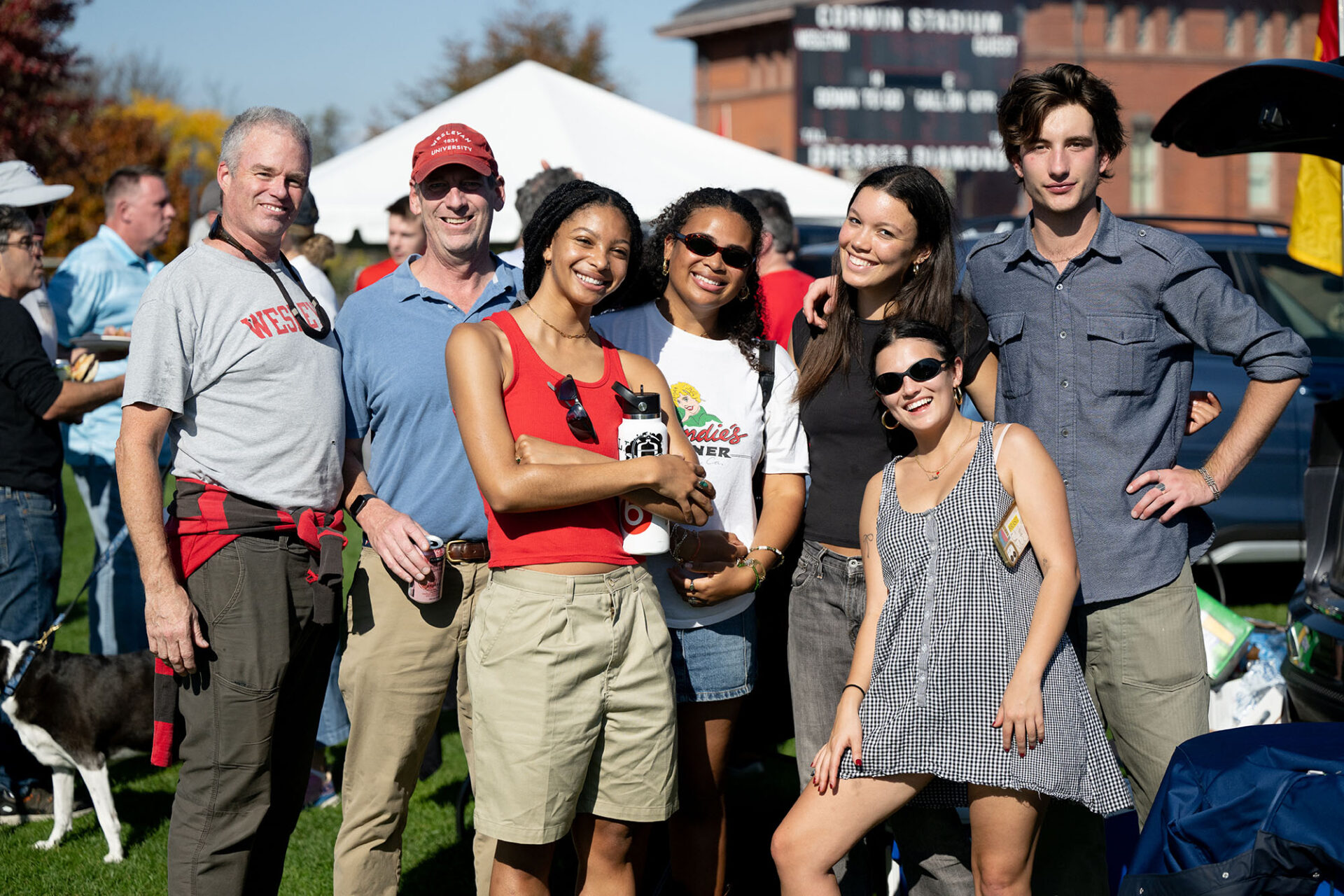Vote of Confidence

After half a century of lackluster turnout, young Americans are voting at record-high rates. What’s driving this swell in participation among Gen Z and Millennials—and what does it signal for the future of electoral politics?
On Tuesday, November 3, 2020, Sita McGuire ’24 woke up early and drove two and a half hours from Middletown to an elementary school near her home in Massachusetts. “I just had this weird vision: For my first election, I really wanted to vote in a building,” she says.
To McGuire, heading to the polling station to cast her first vote symbolized becoming an adult in a way that an absentee ballot never would. Coming from a family that immigrated to the United States from Indonesia, she was a part of a generation that grew up as America’s post-9/11 anxieties churned alongside progress around LGBTQ rights, strides toward health care reform, and the election of the first Black president. By the time she was old enough to vote, she’d seen a collapsing climate and a country increasingly at odds with her progressive values.
“This is a very unique-to-Gen-Z perspective: sometimes it all feels a bit hopeless,” says McGuire, a student coordinator for Wesleyan Reproductive Advocacy and Legislation. “But voting is something where people can feel like, I can take control of this one thing.”
It used to be conventional wisdom that young people were fickle voters. But lately, rising numbers of young Americans have exercised the franchise: In the 2020 presidential election, more than half of voters under 30 (and 77.2 percent of eligible Wesleyan students) cast a record number of ballots. During the last two midterm elections—traditionally lower-profile affairs—young people turned out at the two highest rates in decades. And among Wesleyan students, rates of voter turnout more than doubled from 21.3% in 2014 to 54.6% in 2018—the latter nearly twice the national-level percentage—according to the most recent data from the Institute for Democracy & Higher Education.
If elections have consequences, as the truism goes, so does the makeup of the electorate. Experts credited Millennial and Gen Z voters for rewriting standard midterm-election narratives in 2022, expanding Democrats’ Senate majority and blunting a widely anticipated “red wave” in the House. Within five years most voters will be Millennials and Gen Zers. According to a 2023 analysis by the Brookings Institution, their values and political loyalties will influence American politics for decades to come. (“Both of America’s two parties,” the analysis reads, “would do well to recognize and adapt to the generational dynamics now shaping our country.”) And for some in the Wesleyan community, the ballot is only the beginning.
Opting In
In 1972, a year after the newly ratified Twenty-Sixth Amendment lowered the voting age from 21 to 18, more than half of 18- to 24-year-olds cast ballots in the presidential race between Richard Nixon and George McGovern. But young people’s participation began falling four years later, and with a handful of exceptions like the 1992 and 2008 presidential races, young voters earned a reputation for staying home on election day.
Jane Eisner ’77, a New York-based journalist and author of the 2004 book Taking Back the Vote: Getting American Youth Involved in Our Democracy, offers a range of explanations driving that longstanding narrative: declines in civic education, registration hurdles that affect voters who’ve yet to settle at one address, and partisan gerrymandering that makes voters believe their own ballot is inconsequential. “Young people don’t vote for those reasons. And then, because they don’t vote, candidates don’t pay much attention to their issues—like [campaigning on] Social Security, instead of student loan debt. As a result, young people feel even more cut off from the system because it’s not speaking to them,” Eisner says. “It becomes a vicious cycle when we would want it to be a virtuous cycle.”
Experts credited Millennial and Gen Z voters for rewriting standard midterm-election narratives in 2022, expanding Democrats’ Senate majority and blunting a widely anticipated “red wave” in the House. Within five years most voters will be Millennials and Gen Zers.
Others have long opted out, too. Though 2020 saw the highest level of participation in at least 40 years, the US still trails dozens of other developed countries in voter engagement. Meanwhile, after reaching a 70-year low during the 2014 midterms, the recent increase in voting isn’t limited to the youngest cohort, whose record-setting 2018 still only amounted to 28 percent of eligible voters. “There were widespread increases in voter turnout, especially in the last two midterm elections, that cut across demographic groups,” says Logan Dancey, associate professor of government. “You saw young people turn out at higher rates compared to previous midterms, but you also saw older voters turning out at higher rates as well.” Experts also speculate that without uniquely galvanizing issues, like Donald Trump’s candidacy or the Supreme Court effectively overturning Roe v. Wade, turnout would remain much lower.
Despite those ambiguities, the underlying demographic shifts are clear. Next year Gen Zers and Millennials will represent 37 percent of the electorate, matching Baby Boomers and their elders; their share of voting population is expected to climb to 54.1 percent by 2028. And while these two generations occupy a wide age range—Millennials were born between 1981 and 1996, Gen Z between 1997 and 2012—they share political preferences: Gen Zers and Millennials voted for Joe Biden over Trump by a roughly 20-point margin, according to Pew Research Center, while Gen Xers and Baby Boomers were more evenly split. Many contend that, unlike previous generations, Millennials’ politics have not moved to the right as they’ve grown older. And in some ways, the incipient problems from Millennials’ adolescence—gun violence, climate change, political polarization—have only intensified as Gen Z has aged into the electorate.

“Every year in high school, something big happened,” says Hazel Allison-Way ’24, chief of staff on the Wesleyan Student Assembly and a New Jersey native who goes by they/them pronouns. Trump’s election occurred during their freshman year; sophomore year saw the March for Our Lives movement against gun violence. By junior and senior year, Allison-Way was organizing and speaking at climate strikes and Black Lives Matter marches.
Allison-Way sees activism and electoral politics on the same spectrum. “While you’re doing other radical [stuff], you need to be voting,” they say. They’ve worked on five political campaigns: after volunteering for New Jersey Senator Cory Booker’s 2020 primary push, they hopped onto Biden’s campaign as a facilitator for faith-based organizing—despite not considering themselves religious, and despite their reservations about the Democratic party’s slate of candidates. “However one is feeling about the state of our democracy—personally, I’m not feeling super-great about it—voting shouldn’t be taken for granted,” Allison-Way says. “It’s the tip of the iceberg, but it’s also the bare minimum.”
“It’s about the process of transforming young people and ourselves into lifelong activists and advocates . . . to incubate the next generation of changemakers in their communities—people who, similar to my story, are going to take this passion and fully cultivate it for years and decades to come.”
Melody Oliphant ’13
Beyond the ballot, Millennials and Gen Zers are also pursuing roles within political institutions. Before he was elected Middletown’s youngest mayor in 2019, Ben Florsheim ’14 spent five years as an aide to Senator Chris Murphy, a role that gave him a closer view of the paralysis in Washington. But working for Murphy, whom Florsheim still speaks of fondly, was also an occasion to help mayors, selectmen, state legislators, and city counselors on projects across Connecticut. Florsheim came to see municipal government as a place where public servants could work together across differences and make decisions that affected lives and livelihoods where they resided. “It takes on a very different feel from the remove where federal policymaking puts you,” he says.
Florsheim traces the current surge in civic engagement to the wider response to the 2016 presidential election: the experts were wrong, and everything that once seemed assured now seemed up for grabs. “There’s a sense right now that I do not think existed when I was a Wesleyan student—which wasn’t too long ago, but it feels like an eternity—when the gears of history are turning again, and there’s a responsibility on some level to engage with it.” In the face of an uncertain world, Gen Z and Millennials have displayed a sense of self-possession. “Young people,” Florsheim says, “are realizing they have more power than has been ascribed to them.”
In the Flower of Youth
For a long time, Melody Oliphant ’13 figured her passion for politics would stay something of a hobby, just as it had when she pushed for a bottled water ban as a Wesleyan student studying neuroscience and behavior, or when she balanced work in a neurogenetics research lab in New Haven with volunteering on Hillary Clinton’s 2016 presidential campaign. But Clinton’s defeat and Trump’s victory stirred something in the Georgia native: instead of seeing her country on what she considered a “nonlinear path to progress,” she thought it was lost in the woods.
“I felt, as a white woman from the South, I should do more to put my money where my mouth was,” Oliphant says.
She talked with Andrew Bleeker ’07 and Betti Packman ’07—both political campaign veterans—and hashed out a plan to leave her job and go all-in on political organizing. Then she headed south, first working as a field organizer for the Democratic Party of Virginia, then on Georgia statehouse races and each of Stacey Abrams’s gubernatorial campaigns, including a 2022 role as deputy political director of Abrams’s leadership committee. Instead of climbing onto a national organization or an even higher-profile campaign, Oliphant grew convinced that what affected her and her generation the most was happening right at home. “In so many places across this country, your state government—not the federal government—defines your lived reality,” she says.
In early 2023, Oliphant became executive director of Georgia Youth Justice Coalition (GYJC), a grassroots collective made up of high school and college students from a dozen campuses and 10 counties around the state. Along with activating young people and training them to become political organizers, the group advocates for policies and legislation that affect young people. “When I think about this job, I think about the power we can unleash not just by having young people vote consistently, but by training and coaching them to be real organizers, to be dynamic messengers, to be campaign managers themselves,” Oliphant says. “And when I think about the culture of activism at Wesleyan, it’s one and the same for me: Wesleyan is not a big place in terms of enrollment, but it has an outsized impact on the progressive ecosystem.”
Georgia’s red-to-purple-state metamorphosis, meanwhile, had an outsized impact on national politics in 2020 and 2022. Georgia also has one of the youngest electorates in a battleground state, Oliphant says, and turnout of young Georgian voters doubled between 2014 and 2022. But, speaking days after the 2024 Republican presidential frontrunner was indicted in Fulton County, Oliphant says Trump’s latest transgressions haven’t raised her younger colleagues’ hackles, and they’re ambivalent about Biden’s reelection as well as partisan affiliations in general. “They’re seeking a values-aligned community,” she says, “and they’re often, in many ways, resistant to labels like ‘Democrat’ or ‘progressive,’ or identify with aspects of those labels but don’t see that element of their identity as important.”
And like Oliphant, they’re consumed with making a difference where they live. Weathering death threats and intimidation, GYJC-affiliated students have steadfastly advocated for issues like gun safety, raising Georgia’s minimum wage, climate change, affordable housing, and securing LGBTQ and reproductive rights. Each day of the most recent legislative session in Georgia, GYJC dispatched a student lobbyist to the capitol to build relationships with lawmakers. Recently, the group’s efforts have contributed to overturning book bans, blocking a law modeled on Florida’s so-called “don’t say gay” legislation, and defeating a bill that would have shifted $180 million in public money to private schools.
GYJC’s achievements and Oliphant’s career path reveal a deeper truth. Voting, in everything from national elections to local school board races, is critical to acquiring political power. (Flipping more statehouse seats before the next round of redistricting is the single biggest issue for the Georgia progressive ecosystem, Oliphant says.) But voting is also a way station on a longer journey, one that demands diligent work between election cycles.
“It’s about the process of transforming young people and ourselves into lifelong activists and advocates,” Oliphant says. “Yes, we want to defeat horrible voucher bills that rob our schools of hundreds of millions of dollars, but we also want to incubate the next generation of changemakers in their communities—people who, similar to my story, are going to take this passion and fully cultivate it for years and decades to come.”
It’s a project that means building bridges across generations, from Baby Boomers to 18-year-olds on the way to the polling station for the first time. “I just fundamentally don’t believe young people are going to save us from anything, because it’s not their job to save us,” Oliphant says. “It’s our job to save each other.”



